The KanToo MTM High Sensitivity Two Way |
 |
|
| 2 Aurum Cantus AC-130F1 Woofers | Raw Accoustics RA104.5 Ribbon Tweeter |
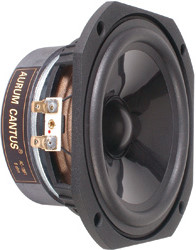 |
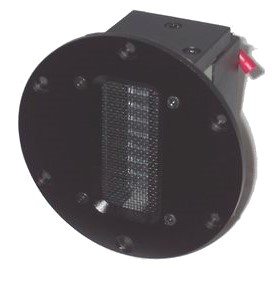 |
Estimated Sensitivity: 90 db, 5-6 ohm nominal 21.5 liter (0.79 cu.ft) ported box,
8" W X 7.5" D X 35" H (3/4" Stock) About 48" Tall in Final Form |
|
Introduction Awhile back, I was contacted by Al Wooley of Raw Acoustics. Al asked if I would be interested in trying a pair of his new ribbons - the RA 104.5. I quickly agreed to work out a design. With the proliferation of small chip amps, and the legions of "bottleheads", we both thought that the RA deserved to go into a tube friendly, high efficiency design that was reasonably priced and something that had not been done before. I looked into drivers from Davis Acoustics, Morel, Tangband, and Aurum Cantus. After a lot of box modelling and consideration of the trade offs, I decided on an MTM with the AC-130F1. The AC-130F1 specs show 89 dB sensitivity and a fairly high DC resistance of 7 ohms. A pair in parallel should be able to push 90+ sensitivity after some baffle step compensation and DCR from the woofer coil. Two also modelled very nicely in a 3/4 cu ft box, showing a predicted F3 of 53 hZ. Specs suggested that these woofers should be able to cross in the 3000 area -- almost a necessity with the RA ribbon. |
 |
 |
Cabinet Construction I used the 3/4 cu. ft. MTM box from Parts Express as a starting point. I chose an 8" baffle width. (You can use those boxes for this design if you choose to do so.) The oddball shape of the drivers presents a bit of a challenge. I thought about creating router templates, but I decided to hit the hobby store. I found 12" X 18" sheets of "craft foam" for about $1 each. Three sheets should stack about 1/4" thick, just about the thickness of the 130F frame. So I decided to surface mount the drivers on 1/4" recessed baffle -- building up the surface with craft foam. Personally, I prefer tower configurations. For my box, the overall height is 45", I used a false bottom (35" from the top). I placed the port into the false bottom. I also created an 18" baffle that I inset 1/4". This is the design you see here. I used 1" damping pads on the top, 1/2" around the top half of the chamber, and lightly stuffed the lower half with dacron. There is only one brace, 2" wide, just below the baffle inset. After looking thru my veneer stock, I decided on a sheet of Zebrano that was rapidly drying out. The bold stripes matched up well with the square corners I chose to use. After a seal coat of dewaxed shellac with a bit of red/brown dye, three coats of Fuhr 355 were applied. I then rubbed out the finish to satin with 600, 1200, 2000 grit papers. The port was mounted in the false bottom, along with a terminal stip after painting the area black. I used 1/2" foam to line the sides in the driver area, and loosely filled the lower chamber with dacron. The crossover is mounted on the back panel and covered with pad of accoustic foam. I covered the recessed baffle area with one layer of craft foam. It makes a great gasket material and proved to be easy to cut and shape. The grills are 3/8" mdf mounted with PE Pressfit Grill Guides (#260-366). I like these much better than the snaplock type for ease of mounting. The plinth is made from strips of off-cut 3/4" baltic birch glued to a 1/2" piece of scrap. I laminated the strips together, sanded them, chamfered the edges with sandpaper, then sprayed 4 coats of "tool dip" rubber aerosol. The glides are adjustable (you could easily do spikes). |
|
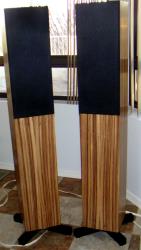 |
|||
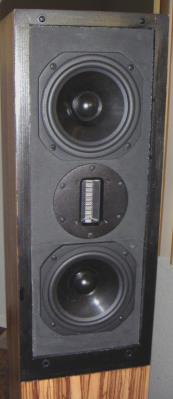 |
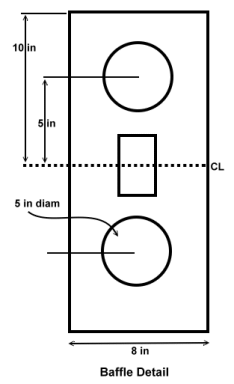 |
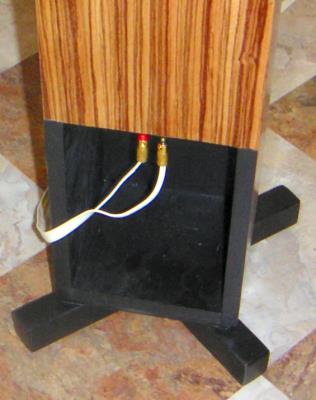 |
Crossover Design and Development The 130's were clean out to about 4500 Hz. The ribbbon showed a rising response from about 2500 out, though I have doubts about the accuracy of my soundcard above 10,000. I tried a variety of topologies and notch filters to smooth everything out and make it as flat as possible. My "final" version uses a simple coil & cap on the woofer with 2 caps & coil on the ribbon. The split padding resistors help with phase alignment. I experimented with measures to flatten the impedance, and to taper top end response. Final crossover is about 3500 Hz. Efforts to lower the crossover, and filter out some of the peaks only served to muddy up the sound. With efficiency in mind, I didn't overdo baffle step compensation. The final response curves show a fairly flat response with a gentle rise. I'm not certain that the dB scale is accurate, I'd estimate 89-90 db sensitivity. I simulated my final baffle configuration with cardboard and masking tape fillers. I expect the final box to be a bit smoother. The impedance curve is benign and should present no major problems for tube amps. It never really drops below 5 ohms. |
|
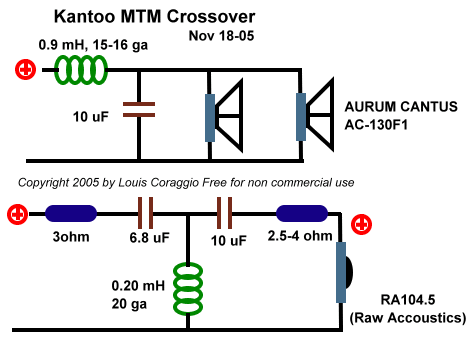 |
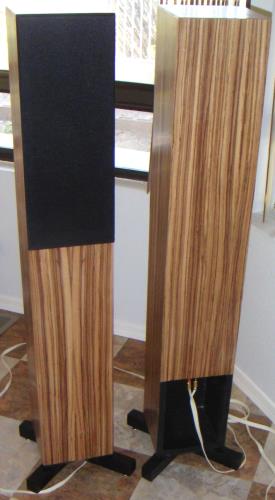 |
Listening Impressions After completing the final boxes and moving the KanToos into a proper room, with decent source material, I am really pleased. (My "reference" system is a Panasonic SAXR50 digital receiver with an optically linked Pioneer DVD player.) I sat down for two hours while covering the grills and listened to a wide variety of new tunes and old favorites. These are very clean and involving speakers. I quickly found myself listening to the music -- not analyzing. Certainly a tribute to these boxes. The KanToo is a bit brighter than most of my designs (with a 2.5 padding resistor). The 104 ribbon is as silky as anything I've ever heard. This is the first box I've ever built where I would up making the padding resistor smaller than predicted. Image holds up very well in both horizontal and vertical off axis listening. The ribbon seems fairly insensitive to padding. A 1 ohm change is barely perceptible so feel free to experiment. Very crisp, airy, without any edge. The system has a very broad soundstage and the imaging holds up very well off axis. There is a definite sweet spot but it seems to be about 3 feet in diameter. Very satisfying. With the box lined and lightly stuffed, the bass is improved in punch and attack. Pushing the system will tax those woofers, but the 50-60 hz bass is solid at all reasonable listening levels-even with the boxes well away from the wall. Baffle step is about 3 dB so I would place these about 8-15 inches from the wall. (As with most of my designs, metal heads will want a sub.) Overall, this is fairly warm to neutral sounding. I really like the vocals and piano work from the 130s. Very smooth, no hint of sibilance. Without my usual BBC dip, these sound a bit more forward than the Cryolites. Where the Cryolites are bit on the clinical/analytical side, the KanToo's are warmer, "mellower" and a tad bit more forgiving. The Cryolite is the clear winner for bass, but it comes at the expense of quite a bit of efficiency. Since I know someone will ask, yes I think you could run these as surface mounted drivers if necessary. The acoustic center of the ribbon is well back into the unit. With horn loading, I would expect the 104 to be less finicky about flush mounting. In my initial listening tests, I had only a single layer of craft foam (essentially surface mounted). I had little to complain about.
|
|
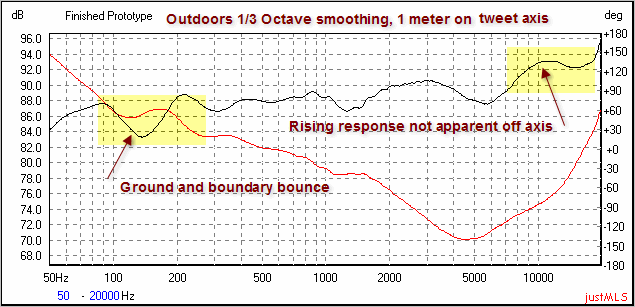 |
|
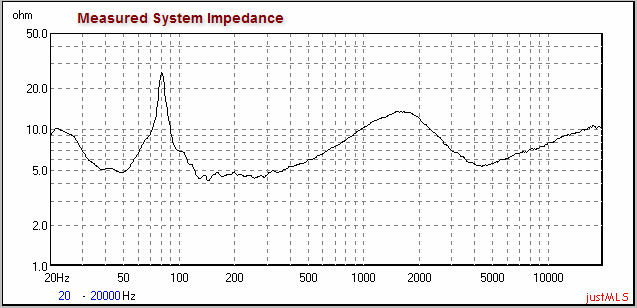 |
|